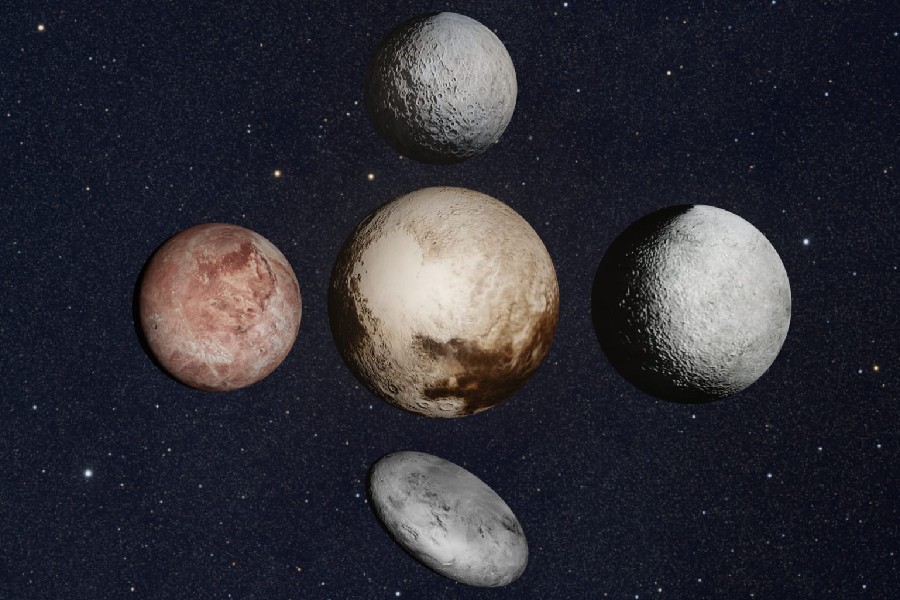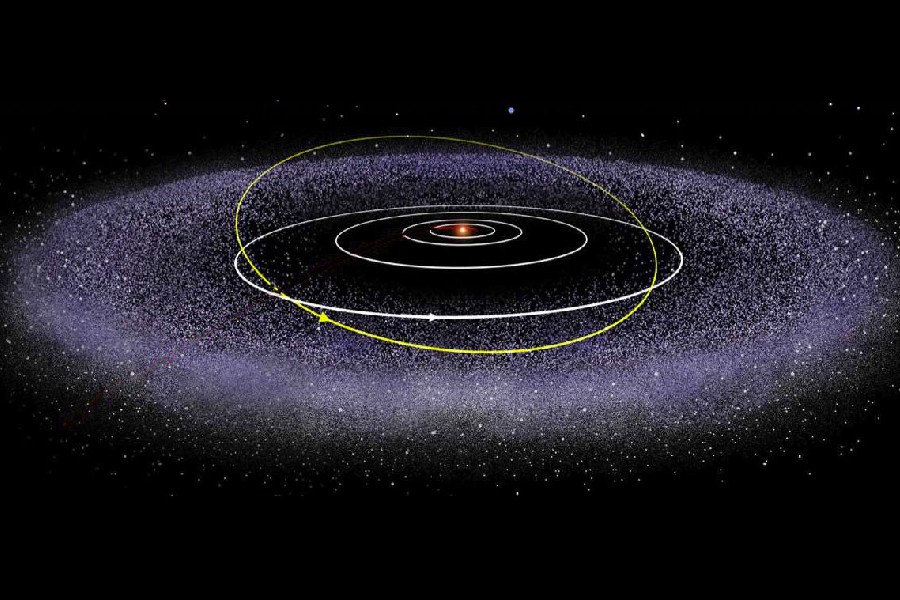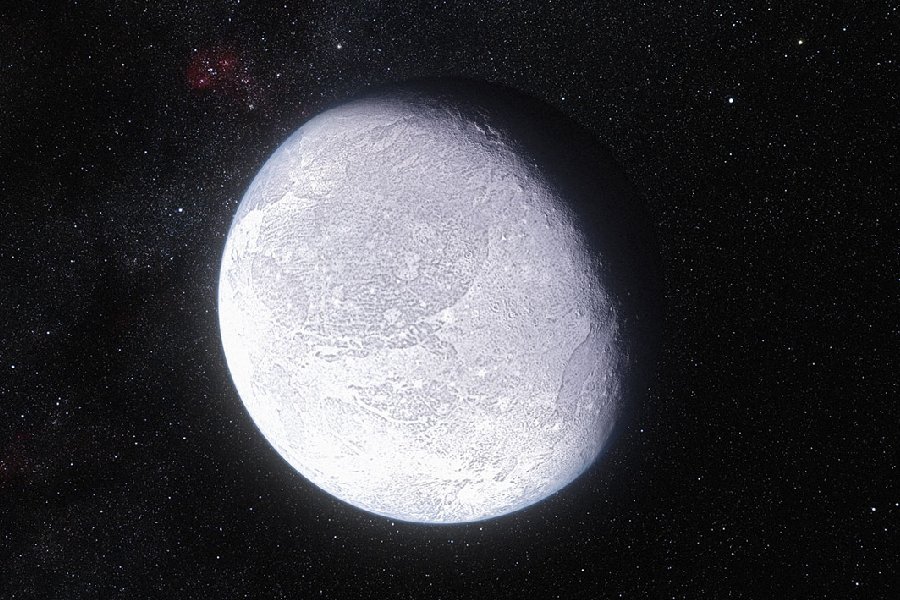There have been many discussions about dwarf planets. The term entered mainstream usage in 2006 when Pluto, long considered the ninth planet, was reclassified as a dwarf planet by the International Astronomical Union (IAU). This prompted questions about what truly defines a planet versus a dwarf planet. But what is a dwarf planet?
In this article, we will explore the official IAU definition of a dwarf planet. We will compare dwarf planets to other small solar system bodies like asteroids. Also, examine the unique physical and orbital traits of what makes a dwarf planet.
Finally, we will examine how discoveries of icy worlds keep expanding the ranks of known dwarf planets at the edges of our solar system. As our understanding of the diversity of objects in our cosmic neighborhood grows, it raises more questions about how we categorize and define these celestial bodies.
Let’s learn more!
What Is a Dwarf Planet?
A dwarf planet is a celestial body that orbits the Sun and shares similarities with planets. Yet, it does not meet all the criteria set by the International Astronomical Union (IAU) for a full-fledged planet.
According to the IAU definition, a dwarf planet must orbit the Sun, and have sufficient mass for a nearly round shape but has not cleared its orbital path of other debris. Notable examples include Pluto, Eris, and Haumea.
While they are not classified as planets, dwarf planets play a crucial role in understanding the solar system, and are often found in regions like the Kuiper Belt.
Dwarf Planets

Characteristics of Dwarf Planets
Size and mass
How are dwarf planets different from regular planets? Dwarf planets, while smaller than traditional planets, exhibit a diverse range of sizes and masses. The typical size of a dwarf planet can vary. But it generally falls within a range that distinguishes it from larger celestial bodies.
Commonly, dwarf planets are significantly smaller than the major planets in our solar system, such as Earth or Jupiter. Their mass is substantial enough for gravity to make them nearly round. But they lack the gravitational dominance seen in larger planets.
Orbital features
Dwarf planets display unique orbital characteristics that set them apart in the solar system. Unlike the more dominant planets that have cleared their orbits of other debris, dwarf planets often share their orbital neighborhoods with other celestial objects.
This means they exist in regions where numerous other bodies, like asteroids and comets, orbit the Sun. The orbital dynamics of dwarf planets reflect a balance between gravitational influences from the Sun and neighboring celestial bodies, contributing to their distinctive positions within the solar system.
Criteria for Classification
International Astronomical Union (IAU) definition
The IAU is the authoritative body responsible for celestial nomenclature and classification. It established specific criteria for classifying a celestial body as a dwarf planet.
According to the IAU definition, a dwarf planet must orbit the Sun and possess sufficient mass for its gravity to shape it into a nearly round shape. Crucially, it has not cleared its orbital path of other debris.
This criterion distinguishes dwarf planets from traditional planets. The latter have cleared their orbits of other objects, demonstrating a higher degree of gravitational dominance.
Comparison with planets
The primary distinction between dwarf and full-fledged planets lies in their ability to clear their orbital paths. While both orbit the Sun and share similarities in terms of shape and orbital behavior, planets have successfully cleared their orbits of other debris. That exhibits a gravitational dominance that sets them apart.
In contrast, dwarf planets, despite their significant mass, coexist with other objects in their orbital vicinity. This highlights a key criterion that separates them from the more gravitationally dominant planets in the solar system.
This differentiation is crucial for accurately categorizing and understanding the diverse array of celestial bodies present in our cosmic neighborhood.

Prominent Dwarf Planets in Our Solar System
Pluto
Discovered in 1930 by astronomer Clyde Tombaugh, Pluto was originally classified as the ninth planet from the Sun. Yet, with the discovery of similar icy bodies in the Kuiper Belt beyond Neptune, astronomers began questioning if Pluto was a major planet.
In 2006, the International Astronomical Union (IAU) officially reclassified Pluto as a dwarf planet. It was based on its small size, icy composition, and orbital path within the Kuiper Belt.
At just 1,188 miles in diameter, Pluto is significantly smaller than the major planets. Its highly elliptical, inclined orbit also crosses Neptune’s path. Also, Pluto has five known moons, including Charon, which is almost half Pluto’s size.
Eris and Haumea
Two other confirmed dwarf planets in our solar system are Eris and Haumea. Eris was discovered in 2005 and is slightly larger than Pluto, with a diameter of approximately 1,445 miles. It has an extremely eccentric orbit that brings it as close as 3.4 billion miles from the Sun and as far as 9.7 billion miles.
Moreover, Haumea has an elongated shape resembling a rugby ball and orbits just beyond Pluto. It has two moons and is unique for its rapid rotational period of just four hours.
Dwarf Planets vs. Asteroids and Moons
Distinctions
Dwarf planets differ from most asteroids because they have sufficient mass and gravity to achieve hydrostatic equilibrium, giving them a nearly round shape. Most asteroids are irregularly shaped bodies composed of rock and metals.
Dwarf planets are also much larger than typical asteroids. Compared to moons, dwarf planets directly orbit the Sun rather than a planet. Plus, they have different formation origins within the solar nebula.
Roles in the solar system
Dwarf planets, along with asteroids and comets, represent remnants from the early solar system when planets were still forming. Asteroids occupy belts between Mars and Jupiter, where planet formation may have been disrupted.
Furthermore, dwarf planets provide evidence of planetary building blocks in the outer solar system. Early in the solar system’s formation, moons most likely originated from debris around the giant planets. Hence, each set of objects gives insights into different evolutionary processes.

The Kuiper Belt and Dwarf Planets
Location and significance
The Kuiper Belt is a region of icy bodies beyond the orbit of Neptune, extending from about 30 to 55 astronomical units from the Sun. It is similar to the asteroid belt but much larger, wider, and likely contains millions of icy objects.
Many dwarf planets exist within the confines of the Kuiper Belt, including Pluto, Eris, Haumea, and Makemake. The International Astronomical Union (IAU) currently considers objects in this region that meet the requirements of hydrostatic equilibrium as dwarf planets.
Additionally, the Kuiper Belt is viewed as a relic of the primordial solar system. Its icy objects provide evidence of early planet formation processes in the outer regions beyond Neptune.
Notable Kuiper Belt objects
In addition to the confirmed dwarf planets, other significant Kuiper Belt objects include:
- Quaoar – A red-hued world about half the size of Pluto with one moon named Weywot. Its reflective properties suggest the presence of water ice and frozen methane.
- Orcus – A Pluto-sized KBO locked in a 2:3 orbital resonance with Neptune. Orcus has a large moon named Vanth that is almost as big as the primary body.
- Varuna – An egg-shaped KBO roughly half Pluto’s diameter. Its rapid rotational period of 6.34 hours contributes to Varuna’s elongated shape.
- Ixion – One of the brightest KBOs. Ixion is about 435 miles wide and takes almost 250 Earth years to complete one orbit around the Sun.
Beyond Our Solar System
Dwarf planets in exoplanetary systems
Most confirmed exoplanets discovered so far are large gas giants akin to Jupiter or hot super-Earths. However, improvements in detection capabilities are beginning to reveal smaller, fainter worlds.
Some distant planets occupying the mass range between Earth and Neptune may qualify as dwarf planets. Yet, conclusively classifying them as such presents challenges.
- TRAPPIST-1 System – This red dwarf star located 40.66 light years away hosts seven Earth-sized exoplanets. TRAPPIST-1d, e, f, and g reside in the star’s habitable zone and are potential ocean worlds. Yet, more data is needed to determine their precise masses and compositions.
- Kepler-1625b – This intriguing exomoon candidate orbits a Jupiter-sized exoplanet in the habitable zone. The exomoon, if confirmed, would be similar in mass to Neptune and could qualify it as a dwarf planet orbiting Kepler-1625b instead of the star. Further observations are required to validate its status.
- HR 8799 e – One of four giant exoplanets orbiting HR 8799, HR 8799 e has a minimum mass of around 10 times that of Earth. With an orbit beyond its star’s equivalent of the Kuiper belt, this Neptune-like world may be considered a dwarf planet. However, forming a definitive classification is currently impossible.
Interesting Facts on Dwarf Planets
- Pluto has a heart-shaped icy plain called Tombaugh Regio spanning 1,000 miles wide. This region is named after Pluto’s discoverer.
- Eris has an extremely reflective surface, reflecting 86% of the Sunlight that reaches it. This is likely due to deposits of frozen methane on its surface.
- Haumea’s rapid rotation gives it one of the most elongated shapes among large solar system objects. Its odd rugby ball-like shape was a surprising discovery.
- Makemake has no known moons, making it unique among the larger Kuiper Belt objects. Several other dwarf planets have at least one identified moon.
- Ceres comprises about a third of the entire mass of the asteroid belt. In 2015, NASA’s Dawn spacecraft provided the first close-up observations of Ceres, confirming its status as a dwarf planet.
Frequently Asked Questions
What is inside a dwarf planet?
Dwarf planets likely contain a rocky core surrounded by a thick mantle of water ice, with a possible subsurface ocean. Unlike terrestrial planets, they are not massive enough to retain hydrogen and helium.
Dwarf planets like Pluto and Eris have interiors distinct from the gas giants. Models suggest their interior structure is differentiated, with denser rocky material sinking inward during formation.
Will our Sun become a red dwarf planet?
No, the Sun will never become a red dwarf star or planet. Red dwarfs are small, cool, main-sequence stars. They represent the most common stellar type in the Milky Way galaxy.
Our Sun is classified as a yellow G-type star on the main sequence. As it evolves, the Sun will eventually exhaust its nuclear fuel and transition into a white dwarf, not a red dwarf.
Are there any known dwarf planets in our solar system that have not yet been visited by spacecraft?
Yes, the dwarf planet Makemake has not yet been visited by any spacecraft as of 2023.
Other confirmed dwarf planets have been visited by passing probes. For example, Pluto, Ceres, and the Haumea system have been observed by flyby missions.
However, Makemake’s distance from the Sun makes it a more challenging target. NASA is considering a flyby mission to Makemake, but no mission is currently scheduled.
How do scientists differentiate between dwarf planets and asteroids?
Scientists differentiate based on several characteristics. Dwarf planets are large enough gravitationally to maintain a nearly round shape, while most asteroids have irregular, rocky bodies.
Dwarf planets have orbits stable enough to clear their orbital path of debris, unlike asteroids sharing space in crowded belts. The composition also differs, with dwarf planets featuring more ice. Finally, dwarf planets orbit the Sun directly rather than another body.

Conclusion
What is a dwarf planet? The question remains a complex one as definitions evolve with discoveries. While distinct from asteroids and traditional planets, dwarf planets occupy an intermediate zone, exhibiting unique traits and orbital dynamics.
Dwarf planets showcase their unique traits, setting them apart from asteroids, comets, and the major planets. Their perplexing intermediate properties between small solar system bodies and full-fledged planets showcase why the dwarf planet designation was warranted.
The delicate balance of planets, dwarf planets, and minor bodies mirrors the lively processes shaping solar systems and the wider cosmos. Every new discovery brings us one step closer to unraveling the multifaceted movements of astronomical objects.
